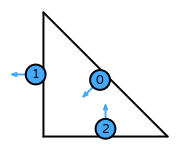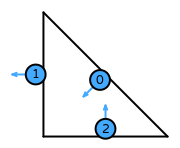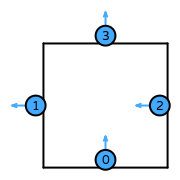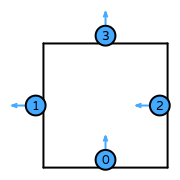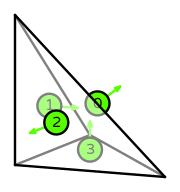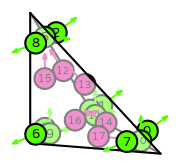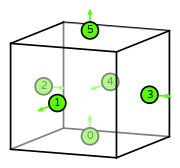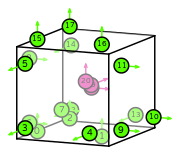Before running this example, you must install
Basix.UFL:
pip install fenics-ufl
pip install fenics-basix
This element can then be created with the following lines of Python:
import basix
import basix.ufl
import numpy as np
# Create Brezzi-Douglas-Fortin-Marini degree 0 on a triangle
e = basix.ufl.custom_element(
basix.CellType.triangle,
(2, ),
np.array([[0.7071067811865475, -5.551115123125783e-17, -1.6653345369377348e-16, 0.0, 0.0, 0.0], [0.0, 0.0, 0.0, 0.7071067811865475, -5.551115123125783e-17, -1.6653345369377348e-16], [0.23570226039551584, -0.08333333333333334, 0.14433756729740632, 0.2357022603955158, 0.16666666666666657, -6.245004513516506e-17]], dtype=np.float64),
[[np.empty((0, 2), dtype=np.float64), np.empty((0, 2), dtype=np.float64), np.empty((0, 2), dtype=np.float64)], [np.array([[0.5, 0.5]], dtype=np.float64), np.array([[0.0, 0.5]], dtype=np.float64), np.array([[0.5, 0.0]], dtype=np.float64)], [np.empty((0, 2), dtype=np.float64)], []],
[[np.empty((0, 2, 0, 1), dtype=np.float64), np.empty((0, 2, 0, 1), dtype=np.float64), np.empty((0, 2, 0, 1), dtype=np.float64)], [np.array([[[[-0.7071067811865476]], [[-0.7071067811865476]]]], dtype=np.float64), np.array([[[[-1.0]], [[0.0]]]], dtype=np.float64), np.array([[[[0.0]], [[1.0]]]], dtype=np.float64)], [np.empty((0, 2, 0, 1), dtype=np.float64)], []],
0,
basix.MapType.contravariantPiola,
basix.SobolevSpace.HDiv,
False,
-1,
1,
basix.PolysetType.standard, dtype=np.float64
)
# Create Brezzi-Douglas-Fortin-Marini degree 1 on a triangle
e = basix.ufl.custom_element(
basix.CellType.triangle,
(2, ),
np.array([[0.7071067811865469, 3.0531133177191805e-16, 5.551115123125783e-16, 1.2490009027033011e-15, 4.718447854656915e-16, 1.5421691701433815e-15, 0.0, 0.0, 0.0, 0.0, 0.0, 0.0], [0.0, 0.0, 0.0, 0.0, 0.0, 0.0, 0.7071067811865469, 3.0531133177191805e-16, 5.551115123125783e-16, 1.2490009027033011e-15, 4.718447854656915e-16, 1.5421691701433815e-15], [0.23570226039551567, -0.08333333333333331, 0.1443375672974068, 3.0531133177191805e-16, 1.3877787807814457e-17, 1.1518563880486e-15, 0.0, 0.0, 0.0, 0.0, 0.0, 0.0], [0.0, 0.0, 0.0, 0.0, 0.0, 0.0, 0.23570226039551567, -0.08333333333333331, 0.1443375672974068, 3.0531133177191805e-16, 1.3877787807814457e-17, 1.1518563880486e-15], [0.2357022603955157, 0.16666666666666693, 1.8735013540549517e-16, 9.43689570931383e-16, 5.689893001203927e-16, 4.475586568020162e-16, 0.0, 0.0, 0.0, 0.0, 0.0, 0.0], [0.0, 0.0, 0.0, 0.0, 0.0, 0.0, 0.2357022603955157, 0.16666666666666693, 1.8735013540549517e-16, 9.43689570931383e-16, 5.689893001203927e-16, 4.475586568020162e-16], [0.17677669529663687, -0.05000000000000001, 0.14433756729740685, -0.006804138174397498, -4.163336342344337e-17, 0.03042903097251027, 0.0, 0.0, 0.0, 0.0, 0.0, 0.0], [0.0, 0.0, 0.0, 0.0, 0.0, 0.0, 0.17677669529663687, 0.15000000000000036, 0.028867513459481492, 0.020412414523194033, 0.02357022603955211, 3.434752482434078e-16], [0.11785113019775795, -0.06666666666666671, 0.11547005383792548, 0.013608276348795474, -0.023570226039551674, 0.030429030972510054, 0.05892556509887891, 0.01666666666666671, 0.02886751345948136, -0.02041241452319297, 0.023570226039551632, 2.0643209364124004e-16]], dtype=np.float64),
[[np.empty((0, 2), dtype=np.float64), np.empty((0, 2), dtype=np.float64), np.empty((0, 2), dtype=np.float64)], [np.array([[0.7886751345948129, 0.21132486540518713], [0.21132486540518713, 0.7886751345948129]], dtype=np.float64), np.array([[0.0, 0.21132486540518713], [0.0, 0.7886751345948129]], dtype=np.float64), np.array([[0.21132486540518713, 0.0], [0.7886751345948129, 0.0]], dtype=np.float64)], [np.array([[0.659027622374092, 0.231933368553031], [0.659027622374092, 0.109039009072877], [0.231933368553031, 0.659027622374092], [0.231933368553031, 0.109039009072877], [0.109039009072877, 0.659027622374092], [0.109039009072877, 0.231933368553031]], dtype=np.float64)], []],
[[np.empty((0, 2, 0, 1), dtype=np.float64), np.empty((0, 2, 0, 1), dtype=np.float64), np.empty((0, 2, 0, 1), dtype=np.float64)], [np.array([[[[-0.27883876791260265], [-0.07471462268067114]], [[-0.27883876791260265], [-0.07471462268067114]]], [[[-0.07471462268067114], [-0.27883876791260265]], [[-0.07471462268067114], [-0.27883876791260265]]]], dtype=np.float64), np.array([[[[-0.39433756729740643], [-0.10566243270259357]], [[0.0], [0.0]]], [[[-0.10566243270259357], [-0.39433756729740643]], [[0.0], [0.0]]]], dtype=np.float64), np.array([[[[0.0], [0.0]], [[0.39433756729740643], [0.10566243270259357]]], [[[0.0], [0.0]], [[0.10566243270259357], [0.39433756729740643]]]], dtype=np.float64)], [np.array([[[[0.06400555262058075], [0.07424674924392691], [0.028414364802159003], [0.07424674924392691], [0.028414364802159003], [0.06400555262058075]], [[0.054918968531174325], [0.054918968531174325], [0.019327780712752582], [0.019327780712752582], [0.009086584089406416], [0.009086584089406416]]], [[[0.019327780712752582], [0.009086584089406416], [0.054918968531174325], [0.009086584089406416], [0.054918968531174325], [0.019327780712752582]], [[0.028414364802159003], [0.028414364802159003], [0.06400555262058075], [0.06400555262058075], [0.07424674924392691], [0.07424674924392691]]], [[[-0.019327780712752582], [-0.009086584089406416], [-0.054918968531174325], [-0.009086584089406416], [-0.054918968531174325], [-0.019327780712752582]], [[0.054918968531174325], [0.054918968531174325], [0.019327780712752582], [0.019327780712752582], [0.009086584089406416], [0.009086584089406416]]]], dtype=np.float64)], []],
0,
basix.MapType.contravariantPiola,
basix.SobolevSpace.HDiv,
False,
-1,
2,
basix.PolysetType.standard, dtype=np.float64
)
# Create Brezzi-Douglas-Fortin-Marini degree 0 on a quadrilateral
e = basix.ufl.custom_element(
basix.CellType.quadrilateral,
(2, ),
np.array([[1.0, 0.0, 0.0, 0.0, 0.0, 0.0, 0.0, 0.0], [0.0, 0.0, 0.0, 0.0, 1.0, 0.0, 0.0, 0.0], [0.5, 0.0, 0.2886751345948128, 0.0, 0.0, 0.0, 0.0, 0.0], [0.0, 0.0, 0.0, 0.0, 0.5, 0.2886751345948128, 0.0, 0.0]], dtype=np.float64),
[[np.empty((0, 2), dtype=np.float64), np.empty((0, 2), dtype=np.float64), np.empty((0, 2), dtype=np.float64), np.empty((0, 2), dtype=np.float64)], [np.array([[0.5, 0.0]], dtype=np.float64), np.array([[0.0, 0.5]], dtype=np.float64), np.array([[1.0, 0.5]], dtype=np.float64), np.array([[0.5, 1.0]], dtype=np.float64)], [np.empty((0, 2), dtype=np.float64)], []],
[[np.empty((0, 2, 0, 1), dtype=np.float64), np.empty((0, 2, 0, 1), dtype=np.float64), np.empty((0, 2, 0, 1), dtype=np.float64), np.empty((0, 2, 0, 1), dtype=np.float64)], [np.array([[[[0.0]], [[1.0]]]], dtype=np.float64), np.array([[[[-1.0]], [[0.0]]]], dtype=np.float64), np.array([[[[-1.0]], [[0.0]]]], dtype=np.float64), np.array([[[[0.0]], [[1.0]]]], dtype=np.float64)], [np.empty((0, 2, 0, 1), dtype=np.float64)], []],
0,
basix.MapType.contravariantPiola,
basix.SobolevSpace.HDiv,
False,
-1,
1,
basix.PolysetType.standard, dtype=np.float64
)
# Create Brezzi-Douglas-Fortin-Marini degree 1 on a quadrilateral
e = basix.ufl.custom_element(
basix.CellType.quadrilateral,
(2, ),
np.array([[0.9999999999999996, 0.0, 0.0, -2.7755575615628914e-17, 0.0, 0.0, 0.0, 0.0, -8.326672684688674e-17, 0.0, 0.0, 0.0, 0.0, 0.0, 0.0, 0.0, 0.0, 0.0], [0.0, 0.0, 0.0, 0.0, 0.0, 0.0, 0.0, 0.0, 0.0, 0.9999999999999996, 0.0, 0.0, -2.7755575615628914e-17, 0.0, 0.0, 0.0, 0.0, -8.326672684688674e-17], [0.49999999999999983, 0.0, -1.3877787807814457e-17, 0.28867513459481275, 0.0, -2.7755575615628914e-17, 0.0, 1.3877787807814457e-17, -4.163336342344337e-17, 0.0, 0.0, 0.0, 0.0, 0.0, 0.0, 0.0, 0.0, 0.0], [0.0, 0.0, 0.0, 0.0, 0.0, 0.0, 0.0, 0.0, 0.0, 0.49999999999999983, 0.0, -1.3877787807814457e-17, 0.28867513459481275, 0.0, -2.7755575615628914e-17, 0.0, 1.3877787807814457e-17, -4.163336342344337e-17], [0.4999999999999998, 0.28867513459481275, 0.0, 0.0, 0.0, 0.0, 1.3877787807814457e-17, -4.163336342344337e-17, -4.163336342344337e-17, 0.0, 0.0, 0.0, 0.0, 0.0, 0.0, 0.0, 0.0, 0.0], [0.0, 0.0, 0.0, 0.0, 0.0, 0.0, 0.0, 0.0, 0.0, 0.4999999999999998, 0.28867513459481275, 0.0, 0.0, 0.0, 0.0, 1.3877787807814457e-17, -4.163336342344337e-17, -4.163336342344337e-17], [0.2499999999999999, 0.14433756729740635, 0.0, 0.14433756729740632, 0.08333333333333329, 0.0, 6.938893903907228e-18, -2.7755575615628914e-17, -1.3877787807814457e-17, 0.0, 0.0, 0.0, 0.0, 0.0, 0.0, 0.0, 0.0, 0.0], [0.0, 0.0, 0.0, 0.0, 0.0, 0.0, 0.0, 0.0, 0.0, 0.2499999999999999, 0.14433756729740635, 0.0, 0.14433756729740632, 0.08333333333333329, 0.0, 6.938893903907228e-18, -2.7755575615628914e-17, -1.3877787807814457e-17], [0.33333333333333315, 0.0, -1.3877787807814457e-17, 0.2886751345948127, 0.0, -2.7755575615628914e-17, 0.07453559924999298, 0.0, -2.0816681711721685e-17, 0.0, 0.0, 0.0, 0.0, 0.0, 0.0, 0.0, 0.0, 0.0], [0.0, 0.0, 0.0, 0.0, 0.0, 0.0, 0.0, 0.0, 0.0, 0.33333333333333315, 0.2886751345948127, 0.07453559924999298, 0.0, 0.0, 0.0, -1.3877787807814457e-17, -4.163336342344337e-17, -1.3877787807814457e-17]], dtype=np.float64),
[[np.empty((0, 2), dtype=np.float64), np.empty((0, 2), dtype=np.float64), np.empty((0, 2), dtype=np.float64), np.empty((0, 2), dtype=np.float64)], [np.array([[0.21132486540518713, 0.0], [0.7886751345948129, 0.0]], dtype=np.float64), np.array([[0.0, 0.21132486540518713], [0.0, 0.7886751345948129]], dtype=np.float64), np.array([[1.0, 0.21132486540518713], [1.0, 0.7886751345948129]], dtype=np.float64), np.array([[0.21132486540518713, 1.0], [0.7886751345948129, 1.0]], dtype=np.float64)], [np.array([[0.21132486540518713, 0.21132486540518713], [0.21132486540518713, 0.7886751345948129], [0.7886751345948129, 0.21132486540518713], [0.7886751345948129, 0.7886751345948129]], dtype=np.float64)], []],
[[np.empty((0, 2, 0, 1), dtype=np.float64), np.empty((0, 2, 0, 1), dtype=np.float64), np.empty((0, 2, 0, 1), dtype=np.float64), np.empty((0, 2, 0, 1), dtype=np.float64)], [np.array([[[[0.0], [0.0]], [[0.39433756729740643], [0.10566243270259357]]], [[[0.0], [0.0]], [[0.10566243270259357], [0.39433756729740643]]]], dtype=np.float64), np.array([[[[-0.39433756729740643], [-0.10566243270259357]], [[0.0], [0.0]]], [[[-0.10566243270259357], [-0.39433756729740643]], [[0.0], [0.0]]]], dtype=np.float64), np.array([[[[-0.39433756729740643], [-0.10566243270259357]], [[0.0], [0.0]]], [[[-0.10566243270259357], [-0.39433756729740643]], [[0.0], [0.0]]]], dtype=np.float64), np.array([[[[0.0], [0.0]], [[0.39433756729740643], [0.10566243270259357]]], [[[0.0], [0.0]], [[0.10566243270259357], [0.39433756729740643]]]], dtype=np.float64)], [np.array([[[[0.25], [0.25], [0.25], [0.25]], [[0.0], [0.0], [0.0], [0.0]]], [[[0.0], [0.0], [0.0], [0.0]], [[0.25], [0.25], [0.25], [0.25]]]], dtype=np.float64)], []],
0,
basix.MapType.contravariantPiola,
basix.SobolevSpace.HDiv,
False,
-1,
2,
basix.PolysetType.standard, dtype=np.float64
)
# Create Brezzi-Douglas-Fortin-Marini degree 0 on a tetrahedron
e = basix.ufl.custom_element(
basix.CellType.tetrahedron,
(3, ),
np.array([[0.40824829046386296, 9.71445146547012e-16, 1.457167719820518e-15, 2.4147350785597155e-15, 0.0, 0.0, 0.0, 0.0, 0.0, 0.0, 0.0, 0.0], [0.0, 0.0, 0.0, 0.0, 0.40824829046386296, 9.71445146547012e-16, 1.457167719820518e-15, 2.4147350785597155e-15, 0.0, 0.0, 0.0, 0.0], [0.0, 0.0, 0.0, 0.0, 0.0, 0.0, 0.0, 0.0, 0.40824829046386296, 9.71445146547012e-16, 1.457167719820518e-15, 2.4147350785597155e-15], [0.10206207261596595, -0.026352313834736255, -0.03726779962499613, 0.06454972243679089, 0.10206207261596595, -0.026352313834736255, 0.07453559924999337, 6.071532165918825e-16, 0.10206207261596595, 0.07905694150420975, 3.712308238590367e-16, 6.071532165918825e-16]], dtype=np.float64),
[[np.empty((0, 3), dtype=np.float64), np.empty((0, 3), dtype=np.float64), np.empty((0, 3), dtype=np.float64), np.empty((0, 3), dtype=np.float64)], [np.empty((0, 3), dtype=np.float64), np.empty((0, 3), dtype=np.float64), np.empty((0, 3), dtype=np.float64), np.empty((0, 3), dtype=np.float64), np.empty((0, 3), dtype=np.float64), np.empty((0, 3), dtype=np.float64)], [np.array([[0.33333333333333337, 0.3333333333333333, 0.3333333333333333]], dtype=np.float64), np.array([[0.0, 0.3333333333333333, 0.3333333333333333]], dtype=np.float64), np.array([[0.3333333333333333, 0.0, 0.3333333333333333]], dtype=np.float64), np.array([[0.3333333333333333, 0.3333333333333333, 0.0]], dtype=np.float64)], [np.empty((0, 3), dtype=np.float64)]],
[[np.empty((0, 3, 0, 1), dtype=np.float64), np.empty((0, 3, 0, 1), dtype=np.float64), np.empty((0, 3, 0, 1), dtype=np.float64), np.empty((0, 3, 0, 1), dtype=np.float64)], [np.empty((0, 3, 0, 1), dtype=np.float64), np.empty((0, 3, 0, 1), dtype=np.float64), np.empty((0, 3, 0, 1), dtype=np.float64), np.empty((0, 3, 0, 1), dtype=np.float64), np.empty((0, 3, 0, 1), dtype=np.float64), np.empty((0, 3, 0, 1), dtype=np.float64)], [np.array([[[[0.28867513459481287]], [[0.28867513459481287]], [[0.28867513459481287]]]], dtype=np.float64), np.array([[[[0.5]], [[0.0]], [[0.0]]]], dtype=np.float64), np.array([[[[0.0]], [[-0.5]], [[0.0]]]], dtype=np.float64), np.array([[[[0.0]], [[0.0]], [[0.5]]]], dtype=np.float64)], [np.empty((0, 3, 0, 1), dtype=np.float64)]],
0,
basix.MapType.contravariantPiola,
basix.SobolevSpace.HDiv,
False,
-1,
1,
basix.PolysetType.standard, dtype=np.float64
)
# Create Brezzi-Douglas-Fortin-Marini degree 1 on a tetrahedron
e = basix.ufl.custom_element(
basix.CellType.tetrahedron,
(3, ),
np.array([[0.40824829046386285, 3.469446951953614e-18, 2.7755575615628914e-17, 1.3877787807814457e-17, -2.0816681711721685e-17, 3.469446951953614e-17, -6.938893903907228e-18, -5.204170427930421e-17, -1.3877787807814457e-17, 5.551115123125783e-17, 0.0, 0.0, 0.0, 0.0, 0.0, 0.0, 0.0, 0.0, 0.0, 0.0, 0.0, 0.0, 0.0, 0.0, 0.0, 0.0, 0.0, 0.0, 0.0, 0.0], [0.0, 0.0, 0.0, 0.0, 0.0, 0.0, 0.0, 0.0, 0.0, 0.0, 0.40824829046386285, 3.469446951953614e-18, 2.7755575615628914e-17, 1.3877787807814457e-17, -2.0816681711721685e-17, 3.469446951953614e-17, -6.938893903907228e-18, -5.204170427930421e-17, -1.3877787807814457e-17, 5.551115123125783e-17, 0.0, 0.0, 0.0, 0.0, 0.0, 0.0, 0.0, 0.0, 0.0, 0.0], [0.0, 0.0, 0.0, 0.0, 0.0, 0.0, 0.0, 0.0, 0.0, 0.0, 0.0, 0.0, 0.0, 0.0, 0.0, 0.0, 0.0, 0.0, 0.0, 0.0, 0.40824829046386285, 3.469446951953614e-18, 2.7755575615628914e-17, 1.3877787807814457e-17, -2.0816681711721685e-17, 3.469446951953614e-17, -6.938893903907228e-18, -5.204170427930421e-17, -1.3877787807814457e-17, 5.551115123125783e-17], [0.1020620726159657, -0.026352313834736487, -0.037267799624996475, 0.06454972243679027, -1.734723475976807e-17, 1.0408340855860843e-17, -1.0408340855860843e-17, -1.734723475976807e-17, -2.42861286636753e-17, 4.163336342344337e-17, 0.0, 0.0, 0.0, 0.0, 0.0, 0.0, 0.0, 0.0, 0.0, 0.0, 0.0, 0.0, 0.0, 0.0, 0.0, 0.0, 0.0, 0.0, 0.0, 0.0], [0.0, 0.0, 0.0, 0.0, 0.0, 0.0, 0.0, 0.0, 0.0, 0.0, 0.1020620726159657, -0.026352313834736487, -0.037267799624996475, 0.06454972243679027, -1.734723475976807e-17, 1.0408340855860843e-17, -1.0408340855860843e-17, -1.734723475976807e-17, -2.42861286636753e-17, 4.163336342344337e-17, 0.0, 0.0, 0.0, 0.0, 0.0, 0.0, 0.0, 0.0, 0.0, 0.0], [0.0, 0.0, 0.0, 0.0, 0.0, 0.0, 0.0, 0.0, 0.0, 0.0, 0.0, 0.0, 0.0, 0.0, 0.0, 0.0, 0.0, 0.0, 0.0, 0.0, 0.1020620726159657, -0.026352313834736487, -0.037267799624996475, 0.06454972243679027, -1.734723475976807e-17, 1.0408340855860843e-17, -1.0408340855860843e-17, -1.734723475976807e-17, -2.42861286636753e-17, 4.163336342344337e-17], [0.10206207261596571, -0.026352313834736484, 0.07453559924999295, 1.734723475976807e-18, -1.9949319973733282e-17, -1.3010426069826053e-18, 0.0, 9.540979117872439e-18, 0.0, -6.071532165918825e-18, 0.0, 0.0, 0.0, 0.0, 0.0, 0.0, 0.0, 0.0, 0.0, 0.0, 0.0, 0.0, 0.0, 0.0, 0.0, 0.0, 0.0, 0.0, 0.0, 0.0], [0.0, 0.0, 0.0, 0.0, 0.0, 0.0, 0.0, 0.0, 0.0, 0.0, 0.10206207261596571, -0.026352313834736484, 0.07453559924999295, 1.734723475976807e-18, -1.9949319973733282e-17, -1.3010426069826053e-18, 0.0, 9.540979117872439e-18, 0.0, -6.071532165918825e-18, 0.0, 0.0, 0.0, 0.0, 0.0, 0.0, 0.0, 0.0, 0.0, 0.0], [0.0, 0.0, 0.0, 0.0, 0.0, 0.0, 0.0, 0.0, 0.0, 0.0, 0.0, 0.0, 0.0, 0.0, 0.0, 0.0, 0.0, 0.0, 0.0, 0.0, 0.10206207261596571, -0.026352313834736484, 0.07453559924999295, 1.734723475976807e-18, -1.9949319973733282e-17, -1.3010426069826053e-18, 0.0, 9.540979117872439e-18, 0.0, -6.071532165918825e-18], [0.10206207261596573, 0.07905694150420947, 6.938893903907228e-18, 1.734723475976807e-18, 2.42861286636753e-17, 2.0816681711721685e-17, 0.0, -2.7755575615628914e-17, 0.0, -6.938893903907228e-18, 0.0, 0.0, 0.0, 0.0, 0.0, 0.0, 0.0, 0.0, 0.0, 0.0, 0.0, 0.0, 0.0, 0.0, 0.0, 0.0, 0.0, 0.0, 0.0, 0.0], [0.0, 0.0, 0.0, 0.0, 0.0, 0.0, 0.0, 0.0, 0.0, 0.0, 0.10206207261596573, 0.07905694150420947, 6.938893903907228e-18, 1.734723475976807e-18, 2.42861286636753e-17, 2.0816681711721685e-17, 0.0, -2.7755575615628914e-17, 0.0, -6.938893903907228e-18, 0.0, 0.0, 0.0, 0.0, 0.0, 0.0, 0.0, 0.0, 0.0, 0.0], [0.0, 0.0, 0.0, 0.0, 0.0, 0.0, 0.0, 0.0, 0.0, 0.0, 0.0, 0.0, 0.0, 0.0, 0.0, 0.0, 0.0, 0.0, 0.0, 0.0, 0.10206207261596573, 0.07905694150420947, 6.938893903907228e-18, 1.734723475976807e-18, 2.42861286636753e-17, 2.0816681711721685e-17, 0.0, -2.7755575615628914e-17, 0.0, -6.938893903907228e-18], [0.08164965809277257, -0.01756820922315765, -0.024845199749997653, 0.06454972243679027, -0.0014847846772912537, -0.002099802627829021, -1.0408340855860843e-17, -0.0025717224993682007, -2.0816681711721685e-17, 0.011501092655705926, 0.0, 0.0, 0.0, 0.0, 0.0, 0.0, 0.0, 0.0, 0.0, 0.0, 0.0, 0.0, 0.0, 0.0, 0.0, 0.0, 0.0, 0.0, 0.0, 0.0], [0.0, 0.0, 0.0, 0.0, 0.0, 0.0, 0.0, 0.0, 0.0, 0.0, 0.08164965809277257, -0.01756820922315765, 0.06832429931249355, 0.010758287072798377, -0.0014847846772912568, 0.0010499013139145135, -0.0018184824186332615, 0.0077151674981046124, 0.008908708063747465, 2.6020852139652106e-18, 0.0, 0.0, 0.0, 0.0, 0.0, 0.0, 0.0, 0.0, 0.0, 0.0], [0.0, 0.0, 0.0, 0.0, 0.0, 0.0, 0.0, 0.0, 0.0, 0.0, 0.0, 0.0, 0.0, 0.0, 0.0, 0.0, 0.0, 0.0, 0.0, 0.0, 0.08164965809277257, 0.07027283689263064, 0.00621129993749942, 0.010758287072798377, 0.005939138709165008, 0.005249506569572612, 0.00909241209316633, -2.0816681711721685e-17, 6.938893903907228e-18, 1.734723475976807e-18], [0.020412414523193142, -0.008784104611578827, 0.006211299937499413, 0.010758287072798373, 0.0014847846772912442, -0.0010499013139145137, -0.0018184824186332597, -0.007715167498104587, 0.008908708063747463, 0.0, 0.04082482904638629, -0.01756820922315766, 0.04969039949999531, 0.0, 0.0029695693545824845, -0.00839921051131616, 0.0, 0.015430334996209204, 0.0, -7.83336069620777e-18, 0.020412414523193145, 0.008784104611578828, 0.012422599874998826, 0.0, -0.005939138709164981, 0.010499013139145185, 0.0, -6.7220534694101275e-18, 0.0, 6.071532165918825e-18], [0.040824829046386284, -0.01756820922315766, -0.024845199749997653, 0.04303314829119351, 0.002969569354582485, 0.004199605255658082, -0.007273929674533084, 0.005143444998736384, -0.008908708063747495, 0.011501092655705928, 0.020412414523193142, -0.008784104611578827, 0.006211299937499413, 0.010758287072798373, 0.0014847846772912442, -0.0010499013139145137, -0.0018184824186332597, -0.007715167498104587, 0.008908708063747463, 0.0, 0.020412414523193142, 0.008784104611578827, -0.006211299937499411, 0.010758287072798373, -0.005939138709164981, -0.005249506569572589, 0.009092412093166333, -2.168404344971009e-18, 6.071532165918825e-18, 0.0], [0.06123724356957942, -0.026352313834736487, -0.01863389981249824, 0.05379143536399189, 0.004454354031873724, 0.003149703941743568, -0.009092412093166344, -0.002571722499368206, -2.949029909160572e-17, 0.011501092655705931, 0.0, 0.0, 0.0, 0.0, 0.0, 0.0, 0.0, 0.0, 0.0, 0.0, 0.020412414523193142, -0.008784104611578827, 0.006211299937499413, 0.010758287072798373, 0.0014847846772912442, -0.0010499013139145137, -0.0018184824186332597, -0.007715167498104587, 0.008908708063747463, 0.0]], dtype=np.float64),
[[np.empty((0, 3), dtype=np.float64), np.empty((0, 3), dtype=np.float64), np.empty((0, 3), dtype=np.float64), np.empty((0, 3), dtype=np.float64)], [np.empty((0, 3), dtype=np.float64), np.empty((0, 3), dtype=np.float64), np.empty((0, 3), dtype=np.float64), np.empty((0, 3), dtype=np.float64), np.empty((0, 3), dtype=np.float64), np.empty((0, 3), dtype=np.float64)], [np.array([[0.109039009072877, 0.659027622374092, 0.231933368553031], [0.23193336855303104, 0.659027622374092, 0.109039009072877], [0.109039009072877, 0.231933368553031, 0.659027622374092], [0.659027622374092, 0.231933368553031, 0.109039009072877], [0.23193336855303104, 0.109039009072877, 0.659027622374092], [0.659027622374092, 0.109039009072877, 0.231933368553031]], dtype=np.float64), np.array([[0.0, 0.659027622374092, 0.231933368553031], [0.0, 0.659027622374092, 0.109039009072877], [0.0, 0.231933368553031, 0.659027622374092], [0.0, 0.231933368553031, 0.109039009072877], [0.0, 0.109039009072877, 0.659027622374092], [0.0, 0.109039009072877, 0.231933368553031]], dtype=np.float64), np.array([[0.659027622374092, 0.0, 0.231933368553031], [0.659027622374092, 0.0, 0.109039009072877], [0.231933368553031, 0.0, 0.659027622374092], [0.231933368553031, 0.0, 0.109039009072877], [0.109039009072877, 0.0, 0.659027622374092], [0.109039009072877, 0.0, 0.231933368553031]], dtype=np.float64), np.array([[0.659027622374092, 0.231933368553031, 0.0], [0.659027622374092, 0.109039009072877, 0.0], [0.231933368553031, 0.659027622374092, 0.0], [0.231933368553031, 0.109039009072877, 0.0], [0.109039009072877, 0.659027622374092, 0.0], [0.109039009072877, 0.231933368553031, 0.0]], dtype=np.float64)], [np.array([[0.25, 0.25, 0.25], [0.5, 0.1666666666666666, 0.1666666666666666], [0.1666666666666666, 0.5, 0.1666666666666666], [0.1666666666666666, 0.1666666666666666, 0.5], [0.1666666666666666, 0.1666666666666666, 0.1666666666666666]], dtype=np.float64)]],
[[np.empty((0, 3, 0, 1), dtype=np.float64), np.empty((0, 3, 0, 1), dtype=np.float64), np.empty((0, 3, 0, 1), dtype=np.float64), np.empty((0, 3, 0, 1), dtype=np.float64)], [np.empty((0, 3, 0, 1), dtype=np.float64), np.empty((0, 3, 0, 1), dtype=np.float64), np.empty((0, 3, 0, 1), dtype=np.float64), np.empty((0, 3, 0, 1), dtype=np.float64), np.empty((0, 3, 0, 1), dtype=np.float64), np.empty((0, 3, 0, 1), dtype=np.float64)], [np.array([[[[0.0052461417700329655], [0.011158899397345762], [0.005246141770032965], [0.031707481265090084], [0.011158899397345762], [0.031707481265090084]], [[0.0052461417700329655], [0.011158899397345762], [0.005246141770032965], [0.031707481265090084], [0.011158899397345762], [0.031707481265090084]], [[0.0052461417700329655], [0.011158899397345762], [0.005246141770032965], [0.031707481265090084], [0.011158899397345762], [0.031707481265090084]]], [[[0.031707481265090084], [0.031707481265090084], [0.01115889939734576], [0.01115889939734576], [0.005246141770032965], [0.005246141770032965]], [[0.031707481265090084], [0.031707481265090084], [0.01115889939734576], [0.01115889939734576], [0.005246141770032965], [0.005246141770032965]], [[0.031707481265090084], [0.031707481265090084], [0.01115889939734576], [0.01115889939734576], [0.005246141770032965], [0.005246141770032965]]], [[[0.01115889939734576], [0.005246141770032965], [0.031707481265090084], [0.005246141770032965], [0.031707481265090084], [0.01115889939734576]], [[0.01115889939734576], [0.005246141770032965], [0.031707481265090084], [0.005246141770032965], [0.031707481265090084], [0.01115889939734576]], [[0.01115889939734576], [0.005246141770032965], [0.031707481265090084], [0.005246141770032965], [0.031707481265090084], [0.01115889939734576]]]], dtype=np.float64), np.array([[[[0.009086584089406418], [0.019327780712752585], [0.009086584089406416], [0.054918968531174325], [0.019327780712752585], [0.054918968531174325]], [[0.0], [0.0], [0.0], [0.0], [0.0], [0.0]], [[0.0], [0.0], [0.0], [0.0], [0.0], [0.0]]], [[[0.054918968531174325], [0.054918968531174325], [0.019327780712752582], [0.019327780712752582], [0.009086584089406416], [0.009086584089406416]], [[0.0], [0.0], [0.0], [0.0], [0.0], [0.0]], [[0.0], [0.0], [0.0], [0.0], [0.0], [0.0]]], [[[0.019327780712752582], [0.009086584089406416], [0.054918968531174325], [0.009086584089406416], [0.054918968531174325], [0.019327780712752582]], [[0.0], [0.0], [0.0], [0.0], [0.0], [0.0]], [[0.0], [0.0], [0.0], [0.0], [0.0], [0.0]]]], dtype=np.float64), np.array([[[[0.0], [0.0], [0.0], [0.0], [0.0], [0.0]], [[-0.009086584089406418], [-0.019327780712752585], [-0.009086584089406416], [-0.054918968531174325], [-0.019327780712752585], [-0.054918968531174325]], [[0.0], [0.0], [0.0], [0.0], [0.0], [0.0]]], [[[0.0], [0.0], [0.0], [0.0], [0.0], [0.0]], [[-0.054918968531174325], [-0.054918968531174325], [-0.019327780712752582], [-0.019327780712752582], [-0.009086584089406416], [-0.009086584089406416]], [[0.0], [0.0], [0.0], [0.0], [0.0], [0.0]]], [[[0.0], [0.0], [0.0], [0.0], [0.0], [0.0]], [[-0.019327780712752582], [-0.009086584089406416], [-0.054918968531174325], [-0.009086584089406416], [-0.054918968531174325], [-0.019327780712752582]], [[0.0], [0.0], [0.0], [0.0], [0.0], [0.0]]]], dtype=np.float64), np.array([[[[0.0], [0.0], [0.0], [0.0], [0.0], [0.0]], [[0.0], [0.0], [0.0], [0.0], [0.0], [0.0]], [[0.009086584089406418], [0.019327780712752585], [0.009086584089406416], [0.054918968531174325], [0.019327780712752585], [0.054918968531174325]]], [[[0.0], [0.0], [0.0], [0.0], [0.0], [0.0]], [[0.0], [0.0], [0.0], [0.0], [0.0], [0.0]], [[0.054918968531174325], [0.054918968531174325], [0.019327780712752582], [0.019327780712752582], [0.009086584089406416], [0.009086584089406416]]], [[[0.0], [0.0], [0.0], [0.0], [0.0], [0.0]], [[0.0], [0.0], [0.0], [0.0], [0.0], [0.0]], [[0.019327780712752582], [0.009086584089406416], [0.054918968531174325], [0.009086584089406416], [0.054918968531174325], [0.019327780712752582]]]], dtype=np.float64)], [np.array([[[[-0.06666666666666667], [0.05], [0.025], [0.025], [0.05]], [[-0.03333333333333333], [0.0375], [0.012499999999999995], [0.012499999999999995], [0.012499999999999995]], [[-0.03333333333333333], [0.0375], [0.012499999999999995], [0.012499999999999995], [0.012499999999999995]]], [[[-0.03333333333333333], [0.012499999999999995], [0.0375], [0.012499999999999995], [0.012499999999999995]], [[-0.06666666666666667], [0.025], [0.05], [0.025], [0.05]], [[-0.03333333333333333], [0.012499999999999995], [0.0375], [0.012499999999999995], [0.012499999999999995]]], [[[-0.03333333333333333], [0.012499999999999995], [0.012499999999999995], [0.0375], [0.012499999999999995]], [[-0.03333333333333333], [0.012499999999999995], [0.012499999999999995], [0.0375], [0.012499999999999995]], [[-0.06666666666666667], [0.025], [0.025], [0.05], [0.05]]], [[[0.03333333333333333], [-0.012499999999999995], [-0.0375], [-0.012499999999999995], [-0.012499999999999995]], [[-0.03333333333333333], [0.0375], [0.012499999999999995], [0.012499999999999995], [0.012499999999999995]], [[-0.0], [0.0], [0.0], [0.0], [0.0]]], [[[0.03333333333333333], [-0.012499999999999995], [-0.012499999999999995], [-0.0375], [-0.012499999999999995]], [[-0.0], [0.0], [0.0], [0.0], [0.0]], [[-0.03333333333333333], [0.0375], [0.012499999999999995], [0.012499999999999995], [0.012499999999999995]]], [[[-0.0], [0.0], [0.0], [0.0], [0.0]], [[0.03333333333333333], [-0.012499999999999995], [-0.012499999999999995], [-0.0375], [-0.012499999999999995]], [[-0.03333333333333333], [0.012499999999999995], [0.0375], [0.012499999999999995], [0.012499999999999995]]]], dtype=np.float64)]],
0,
basix.MapType.contravariantPiola,
basix.SobolevSpace.HDiv,
False,
-1,
2,
basix.PolysetType.standard, dtype=np.float64
)
# Create Brezzi-Douglas-Fortin-Marini degree 0 on a hexahedron
e = basix.ufl.custom_element(
basix.CellType.hexahedron,
(3, ),
np.array([[1.0, 0.0, 0.0, 0.0, 0.0, 0.0, 0.0, 0.0, 0.0, 0.0, 0.0, 0.0, 0.0, 0.0, 0.0, 0.0, 0.0, 0.0, 0.0, 0.0, 0.0, 0.0, 0.0, 0.0], [0.0, 0.0, 0.0, 0.0, 0.0, 0.0, 0.0, 0.0, 1.0, 0.0, 0.0, 0.0, 0.0, 0.0, 0.0, 0.0, 0.0, 0.0, 0.0, 0.0, 0.0, 0.0, 0.0, 0.0], [0.0, 0.0, 0.0, 0.0, 0.0, 0.0, 0.0, 0.0, 0.0, 0.0, 0.0, 0.0, 0.0, 0.0, 0.0, 0.0, 1.0, 0.0, 0.0, 0.0, 0.0, 0.0, 0.0, 0.0], [0.5, 0.0, 0.0, 0.0, 0.2886751345948128, 0.0, 0.0, 0.0, 0.0, 0.0, 0.0, 0.0, 0.0, 0.0, 0.0, 0.0, 0.0, 0.0, 0.0, 0.0, 0.0, 0.0, 0.0, 0.0], [0.0, 0.0, 0.0, 0.0, 0.0, 0.0, 0.0, 0.0, 0.5, 0.0, 0.2886751345948128, 0.0, 0.0, 0.0, 0.0, 0.0, 0.0, 0.0, 0.0, 0.0, 0.0, 0.0, 0.0, 0.0], [0.0, 0.0, 0.0, 0.0, 0.0, 0.0, 0.0, 0.0, 0.0, 0.0, 0.0, 0.0, 0.0, 0.0, 0.0, 0.0, 0.5, 0.2886751345948128, 0.0, 0.0, 0.0, 0.0, 0.0, 0.0]], dtype=np.float64),
[[np.empty((0, 3), dtype=np.float64), np.empty((0, 3), dtype=np.float64), np.empty((0, 3), dtype=np.float64), np.empty((0, 3), dtype=np.float64), np.empty((0, 3), dtype=np.float64), np.empty((0, 3), dtype=np.float64), np.empty((0, 3), dtype=np.float64), np.empty((0, 3), dtype=np.float64)], [np.empty((0, 3), dtype=np.float64), np.empty((0, 3), dtype=np.float64), np.empty((0, 3), dtype=np.float64), np.empty((0, 3), dtype=np.float64), np.empty((0, 3), dtype=np.float64), np.empty((0, 3), dtype=np.float64), np.empty((0, 3), dtype=np.float64), np.empty((0, 3), dtype=np.float64), np.empty((0, 3), dtype=np.float64), np.empty((0, 3), dtype=np.float64), np.empty((0, 3), dtype=np.float64), np.empty((0, 3), dtype=np.float64)], [np.array([[0.5, 0.5, 0.0]], dtype=np.float64), np.array([[0.5, 0.0, 0.5]], dtype=np.float64), np.array([[0.0, 0.5, 0.5]], dtype=np.float64), np.array([[1.0, 0.5, 0.5]], dtype=np.float64), np.array([[0.5, 1.0, 0.5]], dtype=np.float64), np.array([[0.5, 0.5, 1.0]], dtype=np.float64)], [np.empty((0, 3), dtype=np.float64)]],
[[np.empty((0, 3, 0, 1), dtype=np.float64), np.empty((0, 3, 0, 1), dtype=np.float64), np.empty((0, 3, 0, 1), dtype=np.float64), np.empty((0, 3, 0, 1), dtype=np.float64), np.empty((0, 3, 0, 1), dtype=np.float64), np.empty((0, 3, 0, 1), dtype=np.float64), np.empty((0, 3, 0, 1), dtype=np.float64), np.empty((0, 3, 0, 1), dtype=np.float64)], [np.empty((0, 3, 0, 1), dtype=np.float64), np.empty((0, 3, 0, 1), dtype=np.float64), np.empty((0, 3, 0, 1), dtype=np.float64), np.empty((0, 3, 0, 1), dtype=np.float64), np.empty((0, 3, 0, 1), dtype=np.float64), np.empty((0, 3, 0, 1), dtype=np.float64), np.empty((0, 3, 0, 1), dtype=np.float64), np.empty((0, 3, 0, 1), dtype=np.float64), np.empty((0, 3, 0, 1), dtype=np.float64), np.empty((0, 3, 0, 1), dtype=np.float64), np.empty((0, 3, 0, 1), dtype=np.float64), np.empty((0, 3, 0, 1), dtype=np.float64)], [np.array([[[[0.0]], [[0.0]], [[1.0]]]], dtype=np.float64), np.array([[[[0.0]], [[-1.0]], [[0.0]]]], dtype=np.float64), np.array([[[[1.0]], [[0.0]], [[0.0]]]], dtype=np.float64), np.array([[[[1.0]], [[0.0]], [[0.0]]]], dtype=np.float64), np.array([[[[0.0]], [[-1.0]], [[0.0]]]], dtype=np.float64), np.array([[[[0.0]], [[0.0]], [[1.0]]]], dtype=np.float64)], [np.empty((0, 3, 0, 1), dtype=np.float64)]],
0,
basix.MapType.contravariantPiola,
basix.SobolevSpace.HDiv,
False,
-1,
1,
basix.PolysetType.standard, dtype=np.float64
)
# Create Brezzi-Douglas-Fortin-Marini degree 1 on a hexahedron
e = basix.ufl.custom_element(
basix.CellType.hexahedron,
(3, ),
np.array([[0.9999999999999991, 0.0, -3.469446951953614e-17, -1.3877787807814457e-17, -2.7755575615628914e-17, 0.0, 3.122502256758253e-17, -1.3877787807814457e-17, -8.326672684688674e-17, 0.0, -6.938893903907228e-18, 0.0, -6.938893903907228e-18, 0.0, 0.0, -1.3877787807814457e-17, -2.7755575615628914e-17, 0.0, -5.204170427930421e-17, 0.0, -7.632783294297951e-17, -1.0408340855860843e-17, 0.0, -2.7755575615628914e-17, -9.367506770274758e-17, 0.0, -1.3877787807814457e-17, 0.0, 0.0, 0.0, 0.0, 0.0, 0.0, 0.0, 0.0, 0.0, 0.0, 0.0, 0.0, 0.0, 0.0, 0.0, 0.0, 0.0, 0.0, 0.0, 0.0, 0.0, 0.0, 0.0, 0.0, 0.0, 0.0, 0.0, 0.0, 0.0, 0.0, 0.0, 0.0, 0.0, 0.0, 0.0, 0.0, 0.0, 0.0, 0.0, 0.0, 0.0, 0.0, 0.0, 0.0, 0.0, 0.0, 0.0, 0.0, 0.0, 0.0, 0.0, 0.0, 0.0, 0.0], [0.0, 0.0, 0.0, 0.0, 0.0, 0.0, 0.0, 0.0, 0.0, 0.0, 0.0, 0.0, 0.0, 0.0, 0.0, 0.0, 0.0, 0.0, 0.0, 0.0, 0.0, 0.0, 0.0, 0.0, 0.0, 0.0, 0.0, 0.9999999999999991, 0.0, -3.469446951953614e-17, -1.3877787807814457e-17, -2.7755575615628914e-17, 0.0, 3.122502256758253e-17, -1.3877787807814457e-17, -8.326672684688674e-17, 0.0, -6.938893903907228e-18, 0.0, -6.938893903907228e-18, 0.0, 0.0, -1.3877787807814457e-17, -2.7755575615628914e-17, 0.0, -5.204170427930421e-17, 0.0, -7.632783294297951e-17, -1.0408340855860843e-17, 0.0, -2.7755575615628914e-17, -9.367506770274758e-17, 0.0, -1.3877787807814457e-17, 0.0, 0.0, 0.0, 0.0, 0.0, 0.0, 0.0, 0.0, 0.0, 0.0, 0.0, 0.0, 0.0, 0.0, 0.0, 0.0, 0.0, 0.0, 0.0, 0.0, 0.0, 0.0, 0.0, 0.0, 0.0, 0.0, 0.0], [0.0, 0.0, 0.0, 0.0, 0.0, 0.0, 0.0, 0.0, 0.0, 0.0, 0.0, 0.0, 0.0, 0.0, 0.0, 0.0, 0.0, 0.0, 0.0, 0.0, 0.0, 0.0, 0.0, 0.0, 0.0, 0.0, 0.0, 0.0, 0.0, 0.0, 0.0, 0.0, 0.0, 0.0, 0.0, 0.0, 0.0, 0.0, 0.0, 0.0, 0.0, 0.0, 0.0, 0.0, 0.0, 0.0, 0.0, 0.0, 0.0, 0.0, 0.0, 0.0, 0.0, 0.0, 0.9999999999999991, 0.0, -3.469446951953614e-17, -1.3877787807814457e-17, -2.7755575615628914e-17, 0.0, 3.122502256758253e-17, -1.3877787807814457e-17, -8.326672684688674e-17, 0.0, -6.938893903907228e-18, 0.0, -6.938893903907228e-18, 0.0, 0.0, -1.3877787807814457e-17, -2.7755575615628914e-17, 0.0, -5.204170427930421e-17, 0.0, -7.632783294297951e-17, -1.0408340855860843e-17, 0.0, -2.7755575615628914e-17, -9.367506770274758e-17, 0.0, -1.3877787807814457e-17], [0.49999999999999967, 0.0, -1.3877787807814457e-17, -1.3877787807814457e-17, 0.0, 3.469446951953614e-18, -6.938893903907228e-18, 6.938893903907228e-18, -4.85722573273506e-17, 0.28867513459481264, 0.0, 6.938893903907228e-18, 0.0, 0.0, 3.469446951953614e-18, 1.0408340855860843e-17, -6.938893903907228e-18, 1.3877787807814457e-17, -6.938893903907228e-18, 6.938893903907228e-18, -4.85722573273506e-17, -3.469446951953614e-18, 0.0, 6.938893903907228e-18, -3.8163916471489756e-17, 0.0, -2.0816681711721685e-17, 0.0, 0.0, 0.0, 0.0, 0.0, 0.0, 0.0, 0.0, 0.0, 0.0, 0.0, 0.0, 0.0, 0.0, 0.0, 0.0, 0.0, 0.0, 0.0, 0.0, 0.0, 0.0, 0.0, 0.0, 0.0, 0.0, 0.0, 0.0, 0.0, 0.0, 0.0, 0.0, 0.0, 0.0, 0.0, 0.0, 0.0, 0.0, 0.0, 0.0, 0.0, 0.0, 0.0, 0.0, 0.0, 0.0, 0.0, 0.0, 0.0, 0.0, 0.0, 0.0, 0.0, 0.0], [0.0, 0.0, 0.0, 0.0, 0.0, 0.0, 0.0, 0.0, 0.0, 0.0, 0.0, 0.0, 0.0, 0.0, 0.0, 0.0, 0.0, 0.0, 0.0, 0.0, 0.0, 0.0, 0.0, 0.0, 0.0, 0.0, 0.0, 0.49999999999999967, 0.0, -1.3877787807814457e-17, -1.3877787807814457e-17, 0.0, 3.469446951953614e-18, -6.938893903907228e-18, 6.938893903907228e-18, -4.85722573273506e-17, 0.28867513459481264, 0.0, 6.938893903907228e-18, 0.0, 0.0, 3.469446951953614e-18, 1.0408340855860843e-17, -6.938893903907228e-18, 1.3877787807814457e-17, -6.938893903907228e-18, 6.938893903907228e-18, -4.85722573273506e-17, -3.469446951953614e-18, 0.0, 6.938893903907228e-18, -3.8163916471489756e-17, 0.0, -2.0816681711721685e-17, 0.0, 0.0, 0.0, 0.0, 0.0, 0.0, 0.0, 0.0, 0.0, 0.0, 0.0, 0.0, 0.0, 0.0, 0.0, 0.0, 0.0, 0.0, 0.0, 0.0, 0.0, 0.0, 0.0, 0.0, 0.0, 0.0, 0.0], [0.0, 0.0, 0.0, 0.0, 0.0, 0.0, 0.0, 0.0, 0.0, 0.0, 0.0, 0.0, 0.0, 0.0, 0.0, 0.0, 0.0, 0.0, 0.0, 0.0, 0.0, 0.0, 0.0, 0.0, 0.0, 0.0, 0.0, 0.0, 0.0, 0.0, 0.0, 0.0, 0.0, 0.0, 0.0, 0.0, 0.0, 0.0, 0.0, 0.0, 0.0, 0.0, 0.0, 0.0, 0.0, 0.0, 0.0, 0.0, 0.0, 0.0, 0.0, 0.0, 0.0, 0.0, 0.49999999999999967, 0.0, -1.3877787807814457e-17, -1.3877787807814457e-17, 0.0, 3.469446951953614e-18, -6.938893903907228e-18, 6.938893903907228e-18, -4.85722573273506e-17, 0.28867513459481264, 0.0, 6.938893903907228e-18, 0.0, 0.0, 3.469446951953614e-18, 1.0408340855860843e-17, -6.938893903907228e-18, 1.3877787807814457e-17, -6.938893903907228e-18, 6.938893903907228e-18, -4.85722573273506e-17, -3.469446951953614e-18, 0.0, 6.938893903907228e-18, -3.8163916471489756e-17, 0.0, -2.0816681711721685e-17], [0.49999999999999967, 0.0, -2.0816681711721685e-17, 0.28867513459481264, 0.0, -3.469446951953614e-18, -6.938893903907228e-18, 0.0, -3.469446951953614e-17, 1.3877787807814457e-17, -6.938893903907228e-18, 0.0, 0.0, 0.0, -3.469446951953614e-18, 1.0408340855860843e-17, -1.3877787807814457e-17, 0.0, -6.938893903907228e-18, -6.938893903907228e-18, -5.551115123125783e-17, -3.469446951953614e-18, 3.469446951953614e-18, 2.0816681711721685e-17, -3.8163916471489756e-17, 3.469446951953614e-18, -3.122502256758253e-17, 0.0, 0.0, 0.0, 0.0, 0.0, 0.0, 0.0, 0.0, 0.0, 0.0, 0.0, 0.0, 0.0, 0.0, 0.0, 0.0, 0.0, 0.0, 0.0, 0.0, 0.0, 0.0, 0.0, 0.0, 0.0, 0.0, 0.0, 0.0, 0.0, 0.0, 0.0, 0.0, 0.0, 0.0, 0.0, 0.0, 0.0, 0.0, 0.0, 0.0, 0.0, 0.0, 0.0, 0.0, 0.0, 0.0, 0.0, 0.0, 0.0, 0.0, 0.0, 0.0, 0.0, 0.0], [0.0, 0.0, 0.0, 0.0, 0.0, 0.0, 0.0, 0.0, 0.0, 0.0, 0.0, 0.0, 0.0, 0.0, 0.0, 0.0, 0.0, 0.0, 0.0, 0.0, 0.0, 0.0, 0.0, 0.0, 0.0, 0.0, 0.0, 0.49999999999999967, 0.0, -2.0816681711721685e-17, 0.28867513459481264, 0.0, -3.469446951953614e-18, -6.938893903907228e-18, 0.0, -3.469446951953614e-17, 1.3877787807814457e-17, -6.938893903907228e-18, 0.0, 0.0, 0.0, -3.469446951953614e-18, 1.0408340855860843e-17, -1.3877787807814457e-17, 0.0, -6.938893903907228e-18, -6.938893903907228e-18, -5.551115123125783e-17, -3.469446951953614e-18, 3.469446951953614e-18, 2.0816681711721685e-17, -3.8163916471489756e-17, 3.469446951953614e-18, -3.122502256758253e-17, 0.0, 0.0, 0.0, 0.0, 0.0, 0.0, 0.0, 0.0, 0.0, 0.0, 0.0, 0.0, 0.0, 0.0, 0.0, 0.0, 0.0, 0.0, 0.0, 0.0, 0.0, 0.0, 0.0, 0.0, 0.0, 0.0, 0.0], [0.0, 0.0, 0.0, 0.0, 0.0, 0.0, 0.0, 0.0, 0.0, 0.0, 0.0, 0.0, 0.0, 0.0, 0.0, 0.0, 0.0, 0.0, 0.0, 0.0, 0.0, 0.0, 0.0, 0.0, 0.0, 0.0, 0.0, 0.0, 0.0, 0.0, 0.0, 0.0, 0.0, 0.0, 0.0, 0.0, 0.0, 0.0, 0.0, 0.0, 0.0, 0.0, 0.0, 0.0, 0.0, 0.0, 0.0, 0.0, 0.0, 0.0, 0.0, 0.0, 0.0, 0.0, 0.49999999999999967, 0.0, -2.0816681711721685e-17, 0.28867513459481264, 0.0, -3.469446951953614e-18, -6.938893903907228e-18, 0.0, -3.469446951953614e-17, 1.3877787807814457e-17, -6.938893903907228e-18, 0.0, 0.0, 0.0, -3.469446951953614e-18, 1.0408340855860843e-17, -1.3877787807814457e-17, 0.0, -6.938893903907228e-18, -6.938893903907228e-18, -5.551115123125783e-17, -3.469446951953614e-18, 3.469446951953614e-18, 2.0816681711721685e-17, -3.8163916471489756e-17, 3.469446951953614e-18, -3.122502256758253e-17], [0.49999999999999967, 0.28867513459481264, -6.938893903907228e-18, 1.3877787807814457e-17, 6.938893903907228e-18, 6.938893903907228e-18, -4.163336342344337e-17, 1.0408340855860843e-17, -4.5102810375396984e-17, 0.0, 6.938893903907228e-18, 0.0, -6.938893903907228e-18, 0.0, 0.0, -3.469446951953614e-18, -1.3877787807814457e-17, 0.0, -1.3877787807814457e-17, 1.0408340855860843e-17, -5.204170427930421e-17, 6.938893903907228e-18, 6.938893903907228e-18, -3.469446951953614e-18, -4.5102810375396984e-17, 2.42861286636753e-17, -3.642919299551295e-17, 0.0, 0.0, 0.0, 0.0, 0.0, 0.0, 0.0, 0.0, 0.0, 0.0, 0.0, 0.0, 0.0, 0.0, 0.0, 0.0, 0.0, 0.0, 0.0, 0.0, 0.0, 0.0, 0.0, 0.0, 0.0, 0.0, 0.0, 0.0, 0.0, 0.0, 0.0, 0.0, 0.0, 0.0, 0.0, 0.0, 0.0, 0.0, 0.0, 0.0, 0.0, 0.0, 0.0, 0.0, 0.0, 0.0, 0.0, 0.0, 0.0, 0.0, 0.0, 0.0, 0.0, 0.0], [0.0, 0.0, 0.0, 0.0, 0.0, 0.0, 0.0, 0.0, 0.0, 0.0, 0.0, 0.0, 0.0, 0.0, 0.0, 0.0, 0.0, 0.0, 0.0, 0.0, 0.0, 0.0, 0.0, 0.0, 0.0, 0.0, 0.0, 0.49999999999999967, 0.28867513459481264, -6.938893903907228e-18, 1.3877787807814457e-17, 6.938893903907228e-18, 6.938893903907228e-18, -4.163336342344337e-17, 1.0408340855860843e-17, -4.5102810375396984e-17, 0.0, 6.938893903907228e-18, 0.0, -6.938893903907228e-18, 0.0, 0.0, -3.469446951953614e-18, -1.3877787807814457e-17, 0.0, -1.3877787807814457e-17, 1.0408340855860843e-17, -5.204170427930421e-17, 6.938893903907228e-18, 6.938893903907228e-18, -3.469446951953614e-18, -4.5102810375396984e-17, 2.42861286636753e-17, -3.642919299551295e-17, 0.0, 0.0, 0.0, 0.0, 0.0, 0.0, 0.0, 0.0, 0.0, 0.0, 0.0, 0.0, 0.0, 0.0, 0.0, 0.0, 0.0, 0.0, 0.0, 0.0, 0.0, 0.0, 0.0, 0.0, 0.0, 0.0, 0.0], [0.0, 0.0, 0.0, 0.0, 0.0, 0.0, 0.0, 0.0, 0.0, 0.0, 0.0, 0.0, 0.0, 0.0, 0.0, 0.0, 0.0, 0.0, 0.0, 0.0, 0.0, 0.0, 0.0, 0.0, 0.0, 0.0, 0.0, 0.0, 0.0, 0.0, 0.0, 0.0, 0.0, 0.0, 0.0, 0.0, 0.0, 0.0, 0.0, 0.0, 0.0, 0.0, 0.0, 0.0, 0.0, 0.0, 0.0, 0.0, 0.0, 0.0, 0.0, 0.0, 0.0, 0.0, 0.49999999999999967, 0.28867513459481264, -6.938893903907228e-18, 1.3877787807814457e-17, 6.938893903907228e-18, 6.938893903907228e-18, -4.163336342344337e-17, 1.0408340855860843e-17, -4.5102810375396984e-17, 0.0, 6.938893903907228e-18, 0.0, -6.938893903907228e-18, 0.0, 0.0, -3.469446951953614e-18, -1.3877787807814457e-17, 0.0, -1.3877787807814457e-17, 1.0408340855860843e-17, -5.204170427930421e-17, 6.938893903907228e-18, 6.938893903907228e-18, -3.469446951953614e-18, -4.5102810375396984e-17, 2.42861286636753e-17, -3.642919299551295e-17], [0.24999999999999983, 0.14433756729740632, -8.673617379884035e-18, 3.469446951953614e-18, -3.469446951953614e-18, 0.0, -5.204170427930421e-18, 3.469446951953614e-18, -2.2551405187698492e-17, 0.14433756729740632, 0.08333333333333326, 6.938893903907228e-18, -3.469446951953614e-18, 0.0, -3.469446951953614e-18, 3.469446951953614e-18, -3.469446951953614e-18, 0.0, -8.673617379884035e-18, -6.938893903907228e-18, -1.9081958235744878e-17, 0.0, 3.469446951953614e-18, 3.469446951953614e-18, -2.6020852139652106e-17, 6.938893903907228e-18, -6.938893903907228e-18, 0.0, 0.0, 0.0, 0.0, 0.0, 0.0, 0.0, 0.0, 0.0, 0.0, 0.0, 0.0, 0.0, 0.0, 0.0, 0.0, 0.0, 0.0, 0.0, 0.0, 0.0, 0.0, 0.0, 0.0, 0.0, 0.0, 0.0, 0.0, 0.0, 0.0, 0.0, 0.0, 0.0, 0.0, 0.0, 0.0, 0.0, 0.0, 0.0, 0.0, 0.0, 0.0, 0.0, 0.0, 0.0, 0.0, 0.0, 0.0, 0.0, 0.0, 0.0, 0.0, 0.0, 0.0], [0.0, 0.0, 0.0, 0.0, 0.0, 0.0, 0.0, 0.0, 0.0, 0.0, 0.0, 0.0, 0.0, 0.0, 0.0, 0.0, 0.0, 0.0, 0.0, 0.0, 0.0, 0.0, 0.0, 0.0, 0.0, 0.0, 0.0, 0.24999999999999983, 0.14433756729740632, -1.0408340855860843e-17, 0.14433756729740635, 0.08333333333333327, 6.938893903907228e-18, -5.204170427930421e-18, -3.469446951953614e-18, -1.3877787807814457e-17, 3.469446951953614e-18, 3.469446951953614e-18, -3.469446951953614e-18, -3.469446951953614e-18, 0.0, 0.0, -1.0408340855860843e-17, -6.938893903907228e-18, 0.0, -1.214306433183765e-17, 0.0, -2.2551405187698492e-17, -6.938893903907228e-18, 3.469446951953614e-18, 1.3877787807814457e-17, -2.2551405187698492e-17, 1.0408340855860843e-17, -1.5612511283791264e-17, 0.0, 0.0, 0.0, 0.0, 0.0, 0.0, 0.0, 0.0, 0.0, 0.0, 0.0, 0.0, 0.0, 0.0, 0.0, 0.0, 0.0, 0.0, 0.0, 0.0, 0.0, 0.0, 0.0, 0.0, 0.0, 0.0, 0.0], [0.0, 0.0, 0.0, 0.0, 0.0, 0.0, 0.0, 0.0, 0.0, 0.0, 0.0, 0.0, 0.0, 0.0, 0.0, 0.0, 0.0, 0.0, 0.0, 0.0, 0.0, 0.0, 0.0, 0.0, 0.0, 0.0, 0.0, 0.0, 0.0, 0.0, 0.0, 0.0, 0.0, 0.0, 0.0, 0.0, 0.0, 0.0, 0.0, 0.0, 0.0, 0.0, 0.0, 0.0, 0.0, 0.0, 0.0, 0.0, 0.0, 0.0, 0.0, 0.0, 0.0, 0.0, 0.24999999999999983, 0.14433756729740632, -1.0408340855860843e-17, 0.14433756729740635, 0.08333333333333327, 6.938893903907228e-18, -5.204170427930421e-18, -3.469446951953614e-18, -1.3877787807814457e-17, 3.469446951953614e-18, 3.469446951953614e-18, -3.469446951953614e-18, -3.469446951953614e-18, 0.0, 0.0, -1.0408340855860843e-17, -6.938893903907228e-18, 0.0, -1.214306433183765e-17, 0.0, -2.2551405187698492e-17, -6.938893903907228e-18, 3.469446951953614e-18, 1.3877787807814457e-17, -2.2551405187698492e-17, 1.0408340855860843e-17, -1.5612511283791264e-17], [0.24999999999999983, 0.0, -8.673617379884035e-18, 0.14433756729740632, -6.938893903907228e-18, -6.938893903907228e-18, -1.734723475976807e-18, -3.469446951953614e-18, -2.2551405187698492e-17, 0.14433756729740632, 0.0, 6.938893903907228e-18, 0.08333333333333327, 0.0, 0.0, 3.469446951953614e-18, -3.469446951953614e-18, 1.0408340855860843e-17, -8.673617379884035e-18, -3.469446951953614e-18, -1.734723475976807e-17, -6.938893903907228e-18, 6.938893903907228e-18, 1.0408340855860843e-17, -6.938893903907228e-18, 0.0, -5.204170427930421e-18, 0.0, 0.0, 0.0, 0.0, 0.0, 0.0, 0.0, 0.0, 0.0, 0.0, 0.0, 0.0, 0.0, 0.0, 0.0, 0.0, 0.0, 0.0, 0.0, 0.0, 0.0, 0.0, 0.0, 0.0, 0.0, 0.0, 0.0, 0.0, 0.0, 0.0, 0.0, 0.0, 0.0, 0.0, 0.0, 0.0, 0.0, 0.0, 0.0, 0.0, 0.0, 0.0, 0.0, 0.0, 0.0, 0.0, 0.0, 0.0, 0.0, 0.0, 0.0, 0.0, 0.0, 0.0], [0.0, 0.0, 0.0, 0.0, 0.0, 0.0, 0.0, 0.0, 0.0, 0.0, 0.0, 0.0, 0.0, 0.0, 0.0, 0.0, 0.0, 0.0, 0.0, 0.0, 0.0, 0.0, 0.0, 0.0, 0.0, 0.0, 0.0, 0.24999999999999983, 0.0, -8.673617379884035e-18, 0.14433756729740632, -6.938893903907228e-18, -6.938893903907228e-18, -1.734723475976807e-18, -3.469446951953614e-18, -2.2551405187698492e-17, 0.14433756729740632, 0.0, 6.938893903907228e-18, 0.08333333333333327, 0.0, 0.0, 3.469446951953614e-18, -3.469446951953614e-18, 1.0408340855860843e-17, -8.673617379884035e-18, -3.469446951953614e-18, -1.734723475976807e-17, -6.938893903907228e-18, 6.938893903907228e-18, 1.0408340855860843e-17, -6.938893903907228e-18, 0.0, -5.204170427930421e-18, 0.0, 0.0, 0.0, 0.0, 0.0, 0.0, 0.0, 0.0, 0.0, 0.0, 0.0, 0.0, 0.0, 0.0, 0.0, 0.0, 0.0, 0.0, 0.0, 0.0, 0.0, 0.0, 0.0, 0.0, 0.0, 0.0, 0.0], [0.0, 0.0, 0.0, 0.0, 0.0, 0.0, 0.0, 0.0, 0.0, 0.0, 0.0, 0.0, 0.0, 0.0, 0.0, 0.0, 0.0, 0.0, 0.0, 0.0, 0.0, 0.0, 0.0, 0.0, 0.0, 0.0, 0.0, 0.0, 0.0, 0.0, 0.0, 0.0, 0.0, 0.0, 0.0, 0.0, 0.0, 0.0, 0.0, 0.0, 0.0, 0.0, 0.0, 0.0, 0.0, 0.0, 0.0, 0.0, 0.0, 0.0, 0.0, 0.0, 0.0, 0.0, 0.24999999999999983, 0.14433756729740632, -8.673617379884035e-18, 3.469446951953614e-18, -3.469446951953614e-18, 0.0, -5.204170427930421e-18, 3.469446951953614e-18, -2.2551405187698492e-17, 0.14433756729740632, 0.08333333333333326, 6.938893903907228e-18, -3.469446951953614e-18, 0.0, -3.469446951953614e-18, 3.469446951953614e-18, -3.469446951953614e-18, 0.0, -8.673617379884035e-18, -6.938893903907228e-18, -1.9081958235744878e-17, 0.0, 3.469446951953614e-18, 3.469446951953614e-18, -2.6020852139652106e-17, 6.938893903907228e-18, -6.938893903907228e-18], [0.3333333333333331, -6.938893903907228e-18, -6.938893903907228e-18, -2.0816681711721685e-17, 0.0, 0.0, -8.673617379884035e-18, -1.0408340855860843e-17, -2.0816681711721685e-17, 0.28867513459481264, -3.469446951953614e-18, 3.469446951953614e-18, 6.938893903907228e-18, 0.0, -3.469446951953614e-18, 1.734723475976807e-17, 3.469446951953614e-18, -1.0408340855860843e-17, 0.07453559924999296, 0.0, -1.3877787807814457e-17, -6.938893903907228e-18, 3.469446951953614e-18, 3.469446951953614e-18, -2.0816681711721685e-17, 0.0, -1.0408340855860843e-17, 0.0, 0.0, 0.0, 0.0, 0.0, 0.0, 0.0, 0.0, 0.0, 0.0, 0.0, 0.0, 0.0, 0.0, 0.0, 0.0, 0.0, 0.0, 0.0, 0.0, 0.0, 0.0, 0.0, 0.0, 0.0, 0.0, 0.0, 0.0, 0.0, 0.0, 0.0, 0.0, 0.0, 0.0, 0.0, 0.0, 0.0, 0.0, 0.0, 0.0, 0.0, 0.0, 0.0, 0.0, 0.0, 0.0, 0.0, 0.0, 0.0, 0.0, 0.0, 0.0, 0.0, 0.0], [0.0, 0.0, 0.0, 0.0, 0.0, 0.0, 0.0, 0.0, 0.0, 0.0, 0.0, 0.0, 0.0, 0.0, 0.0, 0.0, 0.0, 0.0, 0.0, 0.0, 0.0, 0.0, 0.0, 0.0, 0.0, 0.0, 0.0, 0.3333333333333331, 6.938893903907228e-18, -1.214306433183765e-17, 0.28867513459481264, 0.0, 3.469446951953614e-18, 0.07453559924999298, 0.0, -1.734723475976807e-17, 6.938893903907228e-18, 3.469446951953614e-18, 3.469446951953614e-18, 6.938893903907228e-18, 0.0, 0.0, -1.0408340855860843e-17, 0.0, 0.0, -1.5612511283791264e-17, 3.469446951953614e-18, -2.42861286636753e-17, -3.469446951953614e-17, 3.469446951953614e-18, 6.938893903907228e-18, -6.938893903907228e-18, 0.0, -2.42861286636753e-17, 0.0, 0.0, 0.0, 0.0, 0.0, 0.0, 0.0, 0.0, 0.0, 0.0, 0.0, 0.0, 0.0, 0.0, 0.0, 0.0, 0.0, 0.0, 0.0, 0.0, 0.0, 0.0, 0.0, 0.0, 0.0, 0.0, 0.0], [0.0, 0.0, 0.0, 0.0, 0.0, 0.0, 0.0, 0.0, 0.0, 0.0, 0.0, 0.0, 0.0, 0.0, 0.0, 0.0, 0.0, 0.0, 0.0, 0.0, 0.0, 0.0, 0.0, 0.0, 0.0, 0.0, 0.0, 0.0, 0.0, 0.0, 0.0, 0.0, 0.0, 0.0, 0.0, 0.0, 0.0, 0.0, 0.0, 0.0, 0.0, 0.0, 0.0, 0.0, 0.0, 0.0, 0.0, 0.0, 0.0, 0.0, 0.0, 0.0, 0.0, 0.0, 0.3333333333333331, 0.28867513459481264, 0.07453559924999296, 3.469446951953614e-18, -3.469446951953614e-18, 0.0, -5.204170427930421e-18, -6.938893903907228e-18, -1.734723475976807e-17, -3.469446951953614e-18, -3.469446951953614e-18, 3.469446951953614e-18, 0.0, 0.0, 0.0, -1.0408340855860843e-17, 6.938893903907228e-18, 0.0, -8.673617379884035e-18, -2.0816681711721685e-17, -1.3877787807814457e-17, 0.0, 0.0, -6.938893903907228e-18, -2.0816681711721685e-17, -1.0408340855860843e-17, -1.734723475976807e-18]], dtype=np.float64),
[[np.empty((0, 3), dtype=np.float64), np.empty((0, 3), dtype=np.float64), np.empty((0, 3), dtype=np.float64), np.empty((0, 3), dtype=np.float64), np.empty((0, 3), dtype=np.float64), np.empty((0, 3), dtype=np.float64), np.empty((0, 3), dtype=np.float64), np.empty((0, 3), dtype=np.float64)], [np.empty((0, 3), dtype=np.float64), np.empty((0, 3), dtype=np.float64), np.empty((0, 3), dtype=np.float64), np.empty((0, 3), dtype=np.float64), np.empty((0, 3), dtype=np.float64), np.empty((0, 3), dtype=np.float64), np.empty((0, 3), dtype=np.float64), np.empty((0, 3), dtype=np.float64), np.empty((0, 3), dtype=np.float64), np.empty((0, 3), dtype=np.float64), np.empty((0, 3), dtype=np.float64), np.empty((0, 3), dtype=np.float64)], [np.array([[0.21132486540518713, 0.21132486540518713, 0.0], [0.21132486540518713, 0.7886751345948129, 0.0], [0.7886751345948129, 0.21132486540518713, 0.0], [0.7886751345948129, 0.7886751345948129, 0.0]], dtype=np.float64), np.array([[0.21132486540518713, 0.0, 0.21132486540518713], [0.21132486540518713, 0.0, 0.7886751345948129], [0.7886751345948129, 0.0, 0.21132486540518713], [0.7886751345948129, 0.0, 0.7886751345948129]], dtype=np.float64), np.array([[0.0, 0.21132486540518713, 0.21132486540518713], [0.0, 0.21132486540518713, 0.7886751345948129], [0.0, 0.7886751345948129, 0.21132486540518713], [0.0, 0.7886751345948129, 0.7886751345948129]], dtype=np.float64), np.array([[1.0, 0.21132486540518713, 0.21132486540518713], [1.0, 0.21132486540518713, 0.7886751345948129], [1.0, 0.7886751345948129, 0.21132486540518713], [1.0, 0.7886751345948129, 0.7886751345948129]], dtype=np.float64), np.array([[0.21132486540518713, 1.0, 0.21132486540518713], [0.21132486540518713, 1.0, 0.7886751345948129], [0.7886751345948129, 1.0, 0.21132486540518713], [0.7886751345948129, 1.0, 0.7886751345948129]], dtype=np.float64), np.array([[0.21132486540518713, 0.21132486540518713, 1.0], [0.21132486540518713, 0.7886751345948129, 1.0], [0.7886751345948129, 0.21132486540518713, 1.0], [0.7886751345948129, 0.7886751345948129, 1.0]], dtype=np.float64)], [np.array([[0.21132486540518713, 0.21132486540518713, 0.21132486540518713], [0.21132486540518713, 0.21132486540518713, 0.7886751345948129], [0.21132486540518713, 0.7886751345948129, 0.21132486540518713], [0.21132486540518713, 0.7886751345948129, 0.7886751345948129], [0.7886751345948129, 0.21132486540518713, 0.21132486540518713], [0.7886751345948129, 0.21132486540518713, 0.7886751345948129], [0.7886751345948129, 0.7886751345948129, 0.21132486540518713], [0.7886751345948129, 0.7886751345948129, 0.7886751345948129]], dtype=np.float64)]],
[[np.empty((0, 3, 0, 1), dtype=np.float64), np.empty((0, 3, 0, 1), dtype=np.float64), np.empty((0, 3, 0, 1), dtype=np.float64), np.empty((0, 3, 0, 1), dtype=np.float64), np.empty((0, 3, 0, 1), dtype=np.float64), np.empty((0, 3, 0, 1), dtype=np.float64), np.empty((0, 3, 0, 1), dtype=np.float64), np.empty((0, 3, 0, 1), dtype=np.float64)], [np.empty((0, 3, 0, 1), dtype=np.float64), np.empty((0, 3, 0, 1), dtype=np.float64), np.empty((0, 3, 0, 1), dtype=np.float64), np.empty((0, 3, 0, 1), dtype=np.float64), np.empty((0, 3, 0, 1), dtype=np.float64), np.empty((0, 3, 0, 1), dtype=np.float64), np.empty((0, 3, 0, 1), dtype=np.float64), np.empty((0, 3, 0, 1), dtype=np.float64), np.empty((0, 3, 0, 1), dtype=np.float64), np.empty((0, 3, 0, 1), dtype=np.float64), np.empty((0, 3, 0, 1), dtype=np.float64), np.empty((0, 3, 0, 1), dtype=np.float64)], [np.array([[[[0.0], [0.0], [0.0], [0.0]], [[0.0], [0.0], [0.0], [0.0]], [[0.14433756729740643], [0.0], [0.0], [-0.14433756729740643]]], [[[0.0], [0.0], [0.0], [0.0]], [[0.0], [0.0], [0.0], [0.0]], [[0.052831216351296784], [0.052831216351296784], [0.19716878364870322], [0.19716878364870322]]], [[[0.0], [0.0], [0.0], [0.0]], [[0.0], [0.0], [0.0], [0.0]], [[0.052831216351296784], [0.19716878364870322], [0.052831216351296784], [0.19716878364870322]]]], dtype=np.float64), np.array([[[[0.0], [0.0], [0.0], [0.0]], [[-0.14433756729740643], [0.0], [0.0], [0.14433756729740643]], [[0.0], [0.0], [0.0], [0.0]]], [[[0.0], [0.0], [0.0], [0.0]], [[-0.052831216351296784], [-0.052831216351296784], [-0.19716878364870322], [-0.19716878364870322]], [[0.0], [0.0], [0.0], [0.0]]], [[[0.0], [0.0], [0.0], [0.0]], [[-0.052831216351296784], [-0.19716878364870322], [-0.052831216351296784], [-0.19716878364870322]], [[0.0], [0.0], [0.0], [0.0]]]], dtype=np.float64), np.array([[[[0.14433756729740643], [0.0], [0.0], [-0.14433756729740643]], [[0.0], [0.0], [0.0], [0.0]], [[0.0], [0.0], [0.0], [0.0]]], [[[0.052831216351296784], [0.052831216351296784], [0.19716878364870322], [0.19716878364870322]], [[0.0], [0.0], [0.0], [0.0]], [[0.0], [0.0], [0.0], [0.0]]], [[[0.052831216351296784], [0.19716878364870322], [0.052831216351296784], [0.19716878364870322]], [[0.0], [0.0], [0.0], [0.0]], [[0.0], [0.0], [0.0], [0.0]]]], dtype=np.float64), np.array([[[[0.14433756729740643], [0.0], [0.0], [-0.14433756729740643]], [[0.0], [0.0], [0.0], [0.0]], [[0.0], [0.0], [0.0], [0.0]]], [[[0.052831216351296784], [0.052831216351296784], [0.19716878364870322], [0.19716878364870322]], [[0.0], [0.0], [0.0], [0.0]], [[0.0], [0.0], [0.0], [0.0]]], [[[0.052831216351296784], [0.19716878364870322], [0.052831216351296784], [0.19716878364870322]], [[0.0], [0.0], [0.0], [0.0]], [[0.0], [0.0], [0.0], [0.0]]]], dtype=np.float64), np.array([[[[0.0], [0.0], [0.0], [0.0]], [[-0.14433756729740643], [0.0], [0.0], [0.14433756729740643]], [[0.0], [0.0], [0.0], [0.0]]], [[[0.0], [0.0], [0.0], [0.0]], [[-0.052831216351296784], [-0.052831216351296784], [-0.19716878364870322], [-0.19716878364870322]], [[0.0], [0.0], [0.0], [0.0]]], [[[0.0], [0.0], [0.0], [0.0]], [[-0.052831216351296784], [-0.19716878364870322], [-0.052831216351296784], [-0.19716878364870322]], [[0.0], [0.0], [0.0], [0.0]]]], dtype=np.float64), np.array([[[[0.0], [0.0], [0.0], [0.0]], [[0.0], [0.0], [0.0], [0.0]], [[0.14433756729740643], [0.0], [0.0], [-0.14433756729740643]]], [[[0.0], [0.0], [0.0], [0.0]], [[0.0], [0.0], [0.0], [0.0]], [[0.052831216351296784], [0.052831216351296784], [0.19716878364870322], [0.19716878364870322]]], [[[0.0], [0.0], [0.0], [0.0]], [[0.0], [0.0], [0.0], [0.0]], [[0.052831216351296784], [0.19716878364870322], [0.052831216351296784], [0.19716878364870322]]]], dtype=np.float64)], [np.array([[[[0.125], [0.125], [0.125], [0.125], [0.125], [0.125], [0.125], [0.125]], [[0.0], [0.0], [0.0], [0.0], [0.0], [0.0], [0.0], [0.0]], [[0.0], [0.0], [0.0], [0.0], [0.0], [0.0], [0.0], [0.0]]], [[[0.0], [0.0], [0.0], [0.0], [0.0], [0.0], [0.0], [0.0]], [[0.125], [0.125], [0.125], [0.125], [0.125], [0.125], [0.125], [0.125]], [[0.0], [0.0], [0.0], [0.0], [0.0], [0.0], [0.0], [0.0]]], [[[0.0], [0.0], [0.0], [0.0], [0.0], [0.0], [0.0], [0.0]], [[0.0], [0.0], [0.0], [0.0], [0.0], [0.0], [0.0], [0.0]], [[0.125], [0.125], [0.125], [0.125], [0.125], [0.125], [0.125], [0.125]]]], dtype=np.float64)]],
0,
basix.MapType.contravariantPiola,
basix.SobolevSpace.HDiv,
False,
-1,
2,
basix.PolysetType.standard, dtype=np.float64
)
